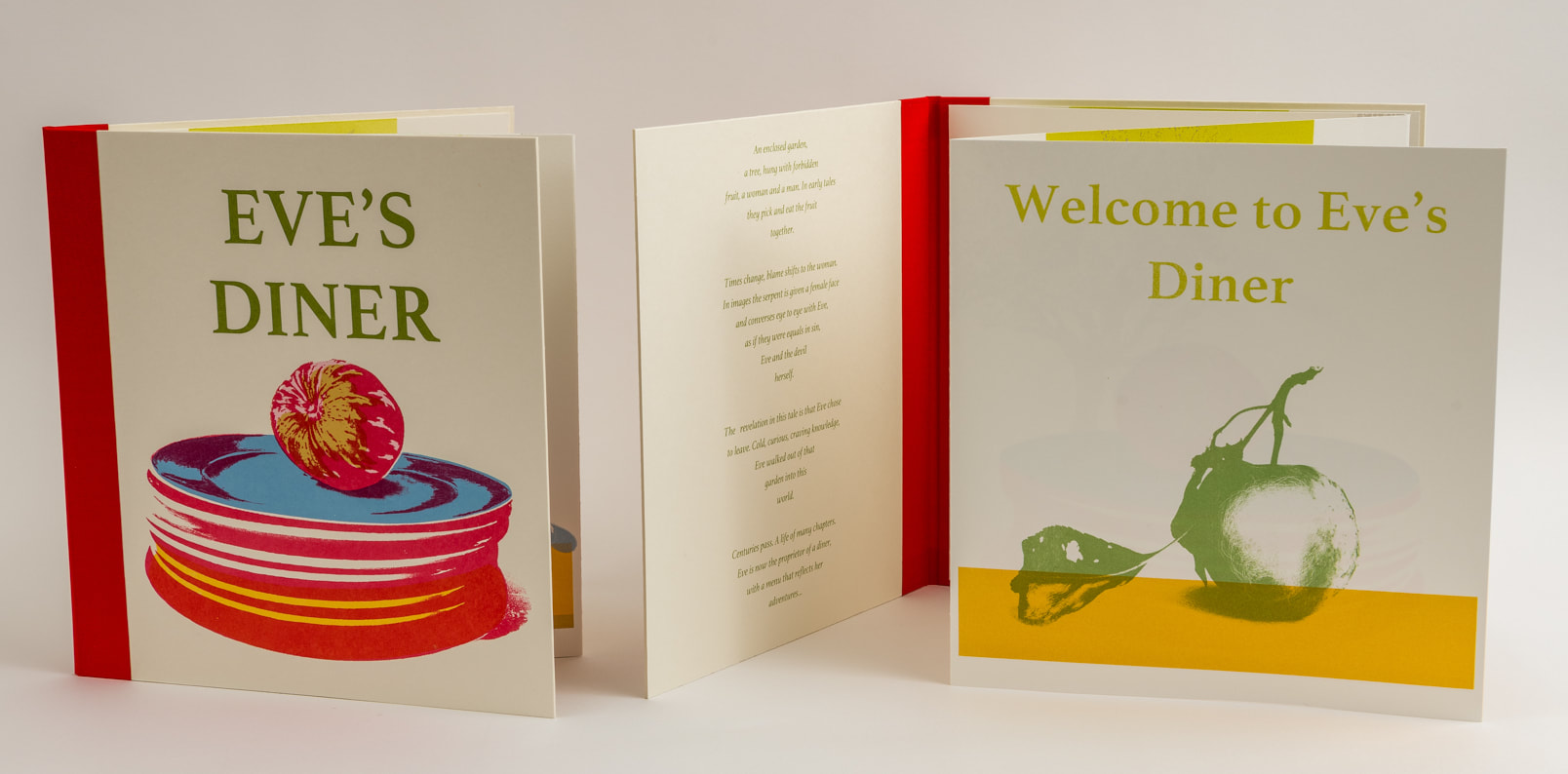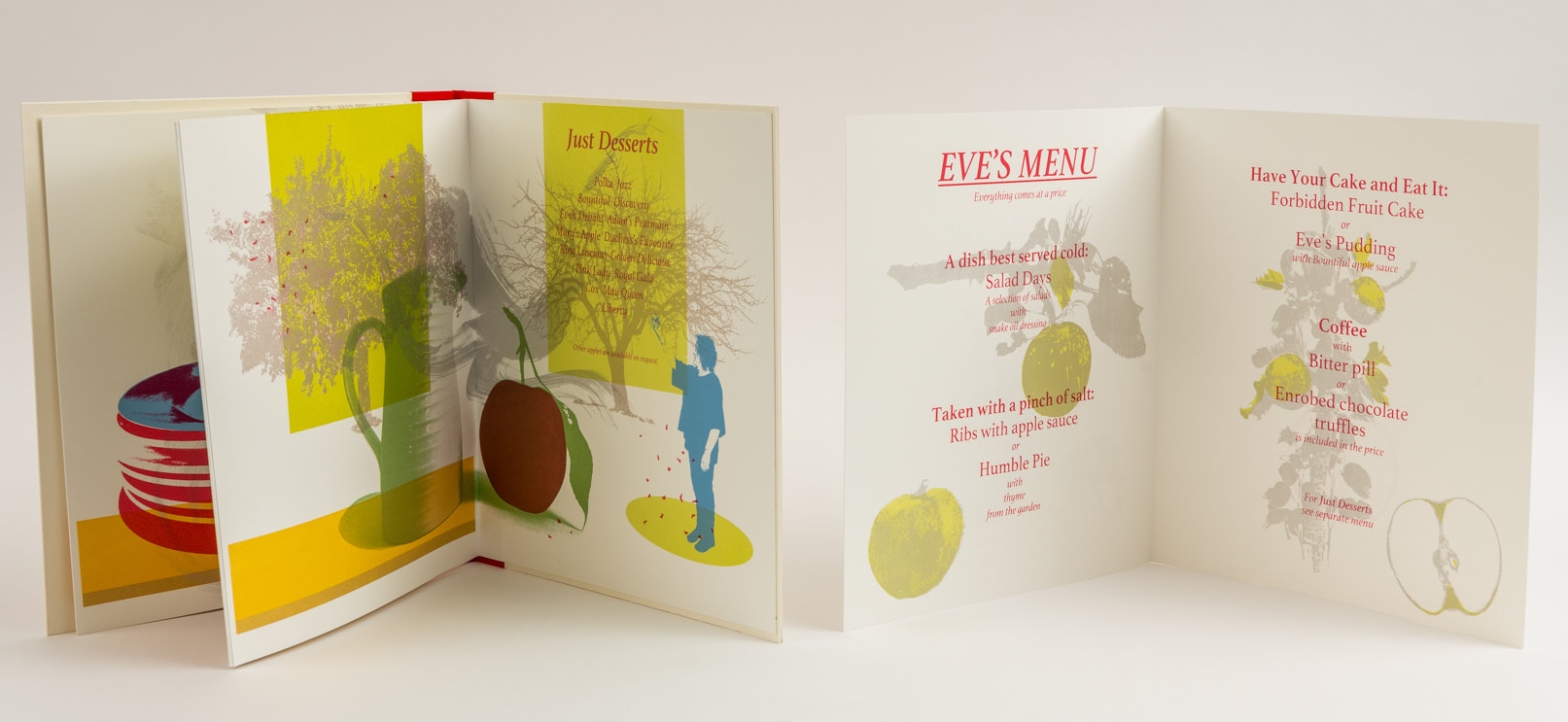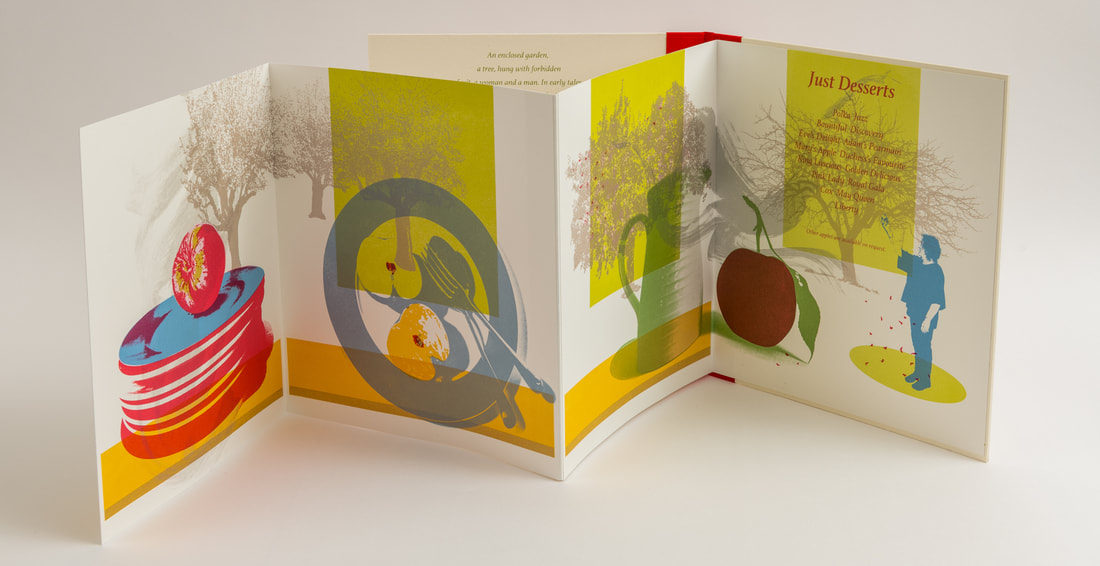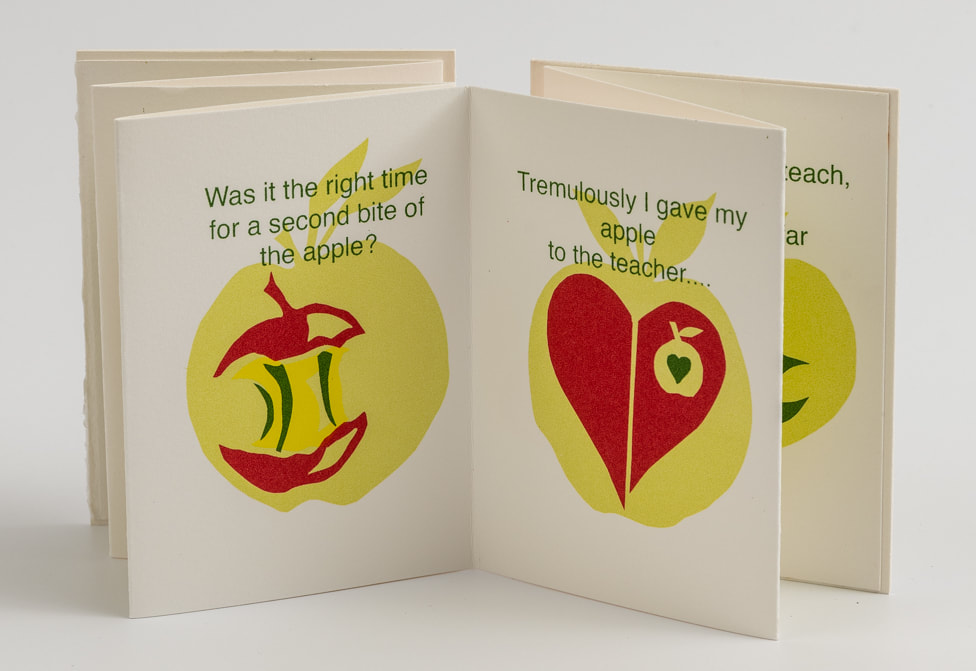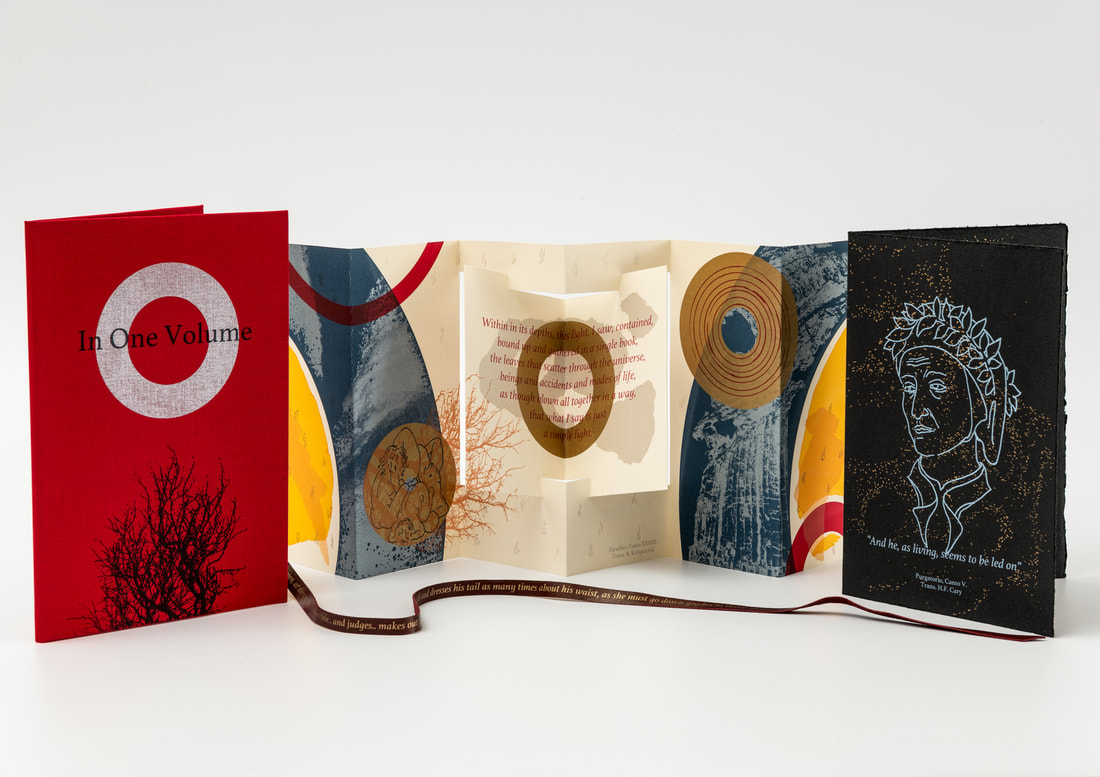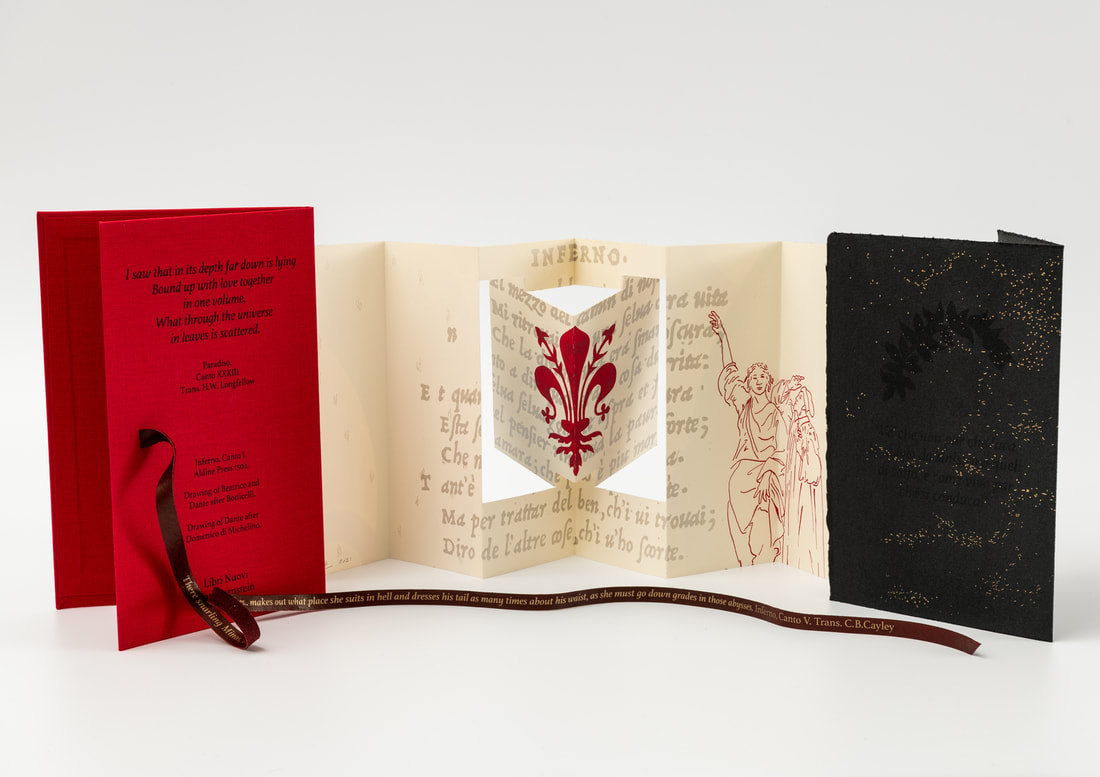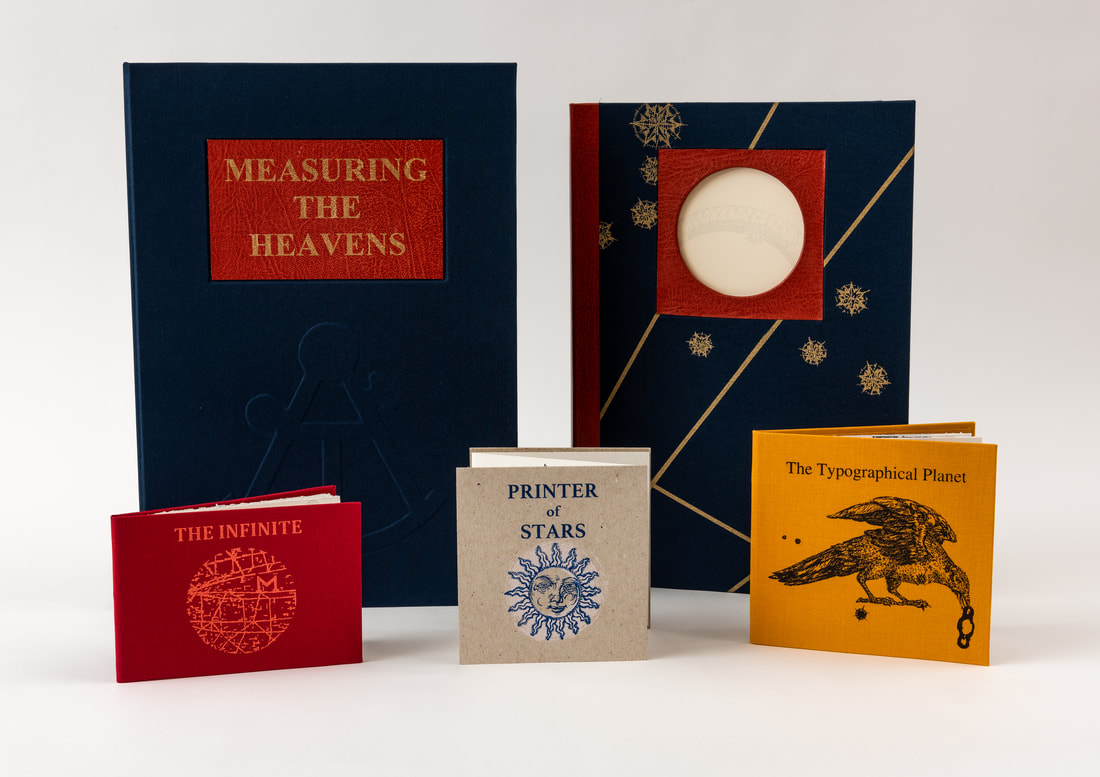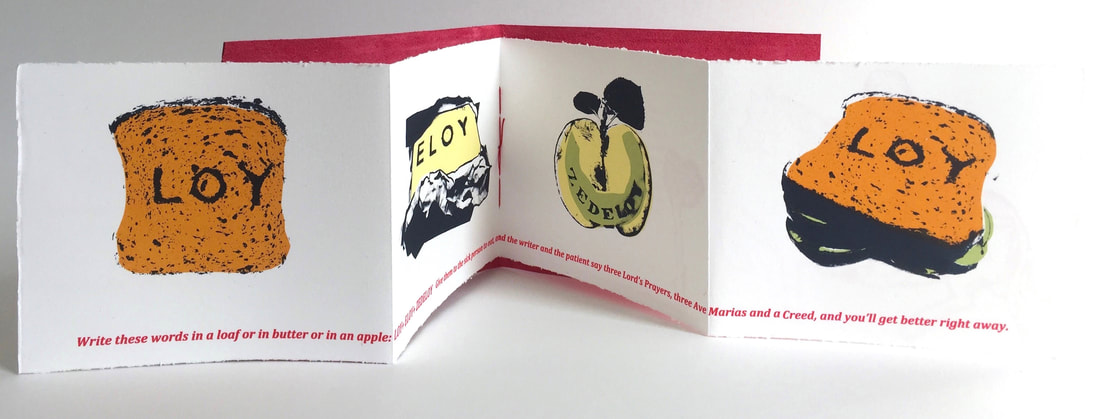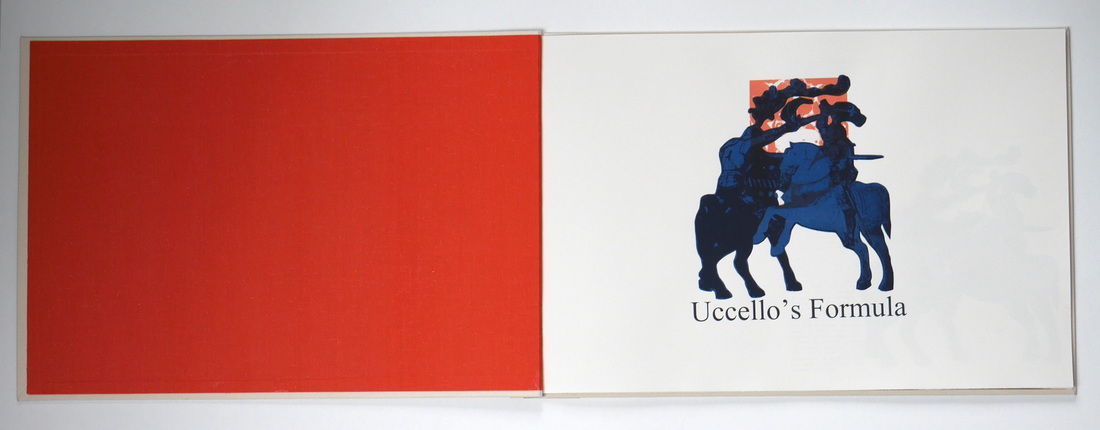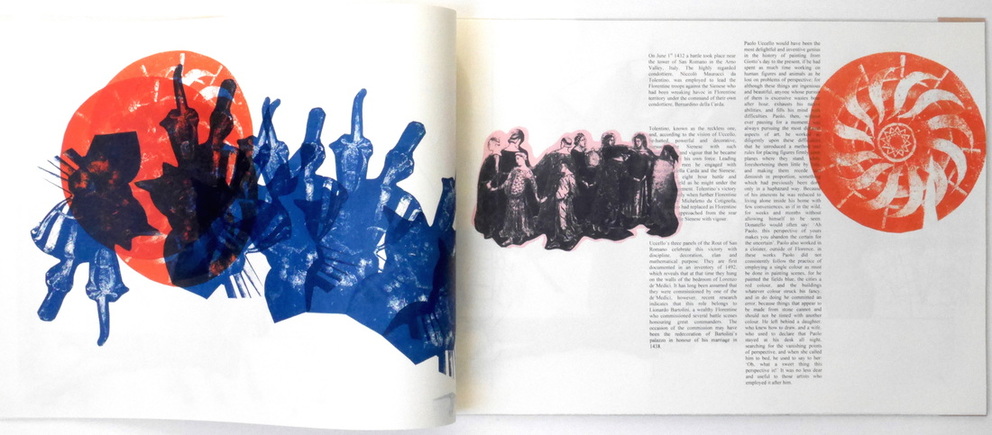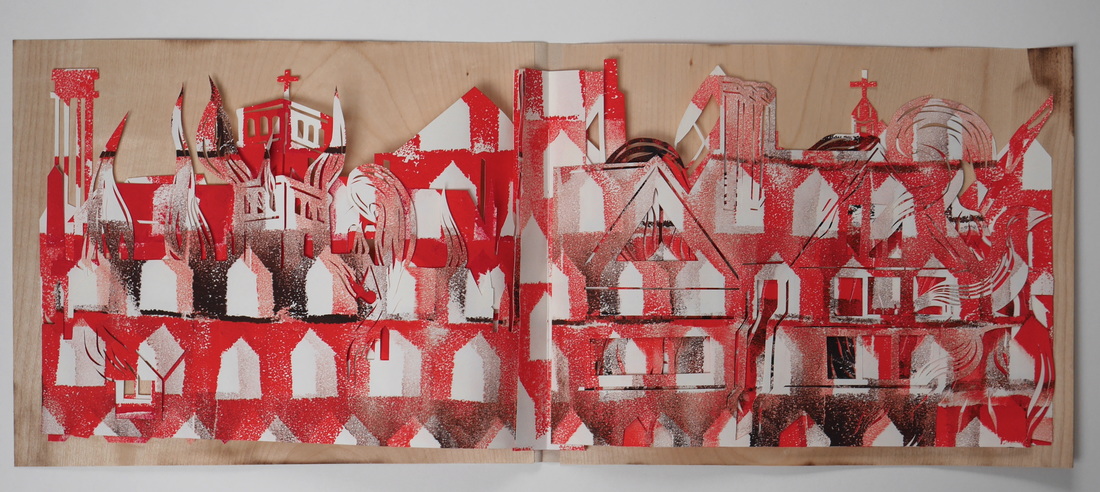BOOKS
Eve's Diner, 2022.
Eve's Diner, 2022.
The book form allows the concertina to be open revealing the diner whilst reading the menu.
Eve's Diner was inspired by changes in the depiction of the story of Adam and Eve. Eve in the medieval period was, on occasion, depicted as equal in sin to the serpent/devil. Images survive of Eve and the serpent conversing in which both have the same female face. Eve's Diner suggests an alternative narrative in which Eve chooses to leave the Garden and embarks upon a series of adventures. In this chapter she is running a Diner with an unusual menu and an orchard in the back garden...
Edition of 15, concertina with separate menu insert, screenprinted on Somerset paper. Conservation board bindings with bookcloth.
Book 30.7cm x 29cm x 1.9cm. Concertina extended 30.7 x 112.5 cm. Menu insert closed 30cm x 28cm, open 30cm x 56cm.
The book form allows the concertina to be open revealing the diner whilst reading the menu.
Eve's Diner was inspired by changes in the depiction of the story of Adam and Eve. Eve in the medieval period was, on occasion, depicted as equal in sin to the serpent/devil. Images survive of Eve and the serpent conversing in which both have the same female face. Eve's Diner suggests an alternative narrative in which Eve chooses to leave the Garden and embarks upon a series of adventures. In this chapter she is running a Diner with an unusual menu and an orchard in the back garden...
Edition of 15, concertina with separate menu insert, screenprinted on Somerset paper. Conservation board bindings with bookcloth.
Book 30.7cm x 29cm x 1.9cm. Concertina extended 30.7 x 112.5 cm. Menu insert closed 30cm x 28cm, open 30cm x 56cm.
Details of Eve's Diner, 2022.
The Apple of My Eye, 2022.
The Apple of My Eye, 2022.
A love story based on common sayings referencing apples. A homage to the graphic style of the 1970's and the rich strangeness of the English language.
Edition of 20, concertina screenprinted on Somerset paper. Conservation board bindings.
Book 13.5cm x 10.4cm x 0.9cm, concertina extended 77.5cm x 10cm.
A love story based on common sayings referencing apples. A homage to the graphic style of the 1970's and the rich strangeness of the English language.
Edition of 20, concertina screenprinted on Somerset paper. Conservation board bindings.
Book 13.5cm x 10.4cm x 0.9cm, concertina extended 77.5cm x 10cm.
Libri Nuovi, a celebration of the life and work of Dante.
In One Volume, 2021.
In One Volume, 2021.
In One Volume, 2021.
A multi-layered response to Dante’s Commedia, and the translators and artists who have been inspired by it. In an echo of the rich experience of reading Dante, references within the work are both explicit and hidden, drawing directly on the original text and referencing the work of other artists and translators. It was created in response to Libri Nuovi; a celebration of the life and work of Dante in the 700th year since his death, organised and curated by Dr Rhiannon Daniels, Associate Professor in Italian and Dr Tristan Kay, Senior Lecturer in Italian Studies, both University of Bristol, and artists John McDowall and Sophie Loss. Eight book artists were commissioned to create new works for an exhibition and events at Bristol University.
With an interplay of abstraction, image and colour, realised in screenprint In One Volume utilises artwork created through drawing, digital and paper stencils. It incorporates photographic imagery of water, rocks and trees echoing the physicality in the description of the landscape of the Commedia. Circles and parts of circles are the main motif of the front of the inner book with one complete circle filled with figures and another with hand drawn concentric outlines that echo the marking of lines on a manuscript page. The book has a three-part structure; a cloth-bound case binding with a tie closure contains a black paper folio, within which is a concertina with a projecting central form that implies an open book.
The three-part structure echoes Dante’s extensive use of the number three in the form and organization of Commedia. The structure also reflects the relationship between Dante as poet and as pilgrim. The folio, in text and image, references Dante the poet’s exile and contains the concertina which reflects Dante as pilgrim; both characterisations are then encapsulated by the third part, the binding, which represents the book form. The binding is closed with a wrap around tie printed with Cayley’s translation of Inferno, Canto V, in which Minos wraps his tail around a sinner a number of times to signify to which circle of Hell the sinner should be sent. The text printed tie is the sole method of closure, text being the essential element that brings together the whole.
Edition of 12, screenprinted, on Somerset paper, bound in book cloth with leather tie.
Book 23.5cm x 16cm x 1.5cm, Concertina extended 54cm x 21cm,
Folio open 22cm x 30cm.
A multi-layered response to Dante’s Commedia, and the translators and artists who have been inspired by it. In an echo of the rich experience of reading Dante, references within the work are both explicit and hidden, drawing directly on the original text and referencing the work of other artists and translators. It was created in response to Libri Nuovi; a celebration of the life and work of Dante in the 700th year since his death, organised and curated by Dr Rhiannon Daniels, Associate Professor in Italian and Dr Tristan Kay, Senior Lecturer in Italian Studies, both University of Bristol, and artists John McDowall and Sophie Loss. Eight book artists were commissioned to create new works for an exhibition and events at Bristol University.
With an interplay of abstraction, image and colour, realised in screenprint In One Volume utilises artwork created through drawing, digital and paper stencils. It incorporates photographic imagery of water, rocks and trees echoing the physicality in the description of the landscape of the Commedia. Circles and parts of circles are the main motif of the front of the inner book with one complete circle filled with figures and another with hand drawn concentric outlines that echo the marking of lines on a manuscript page. The book has a three-part structure; a cloth-bound case binding with a tie closure contains a black paper folio, within which is a concertina with a projecting central form that implies an open book.
The three-part structure echoes Dante’s extensive use of the number three in the form and organization of Commedia. The structure also reflects the relationship between Dante as poet and as pilgrim. The folio, in text and image, references Dante the poet’s exile and contains the concertina which reflects Dante as pilgrim; both characterisations are then encapsulated by the third part, the binding, which represents the book form. The binding is closed with a wrap around tie printed with Cayley’s translation of Inferno, Canto V, in which Minos wraps his tail around a sinner a number of times to signify to which circle of Hell the sinner should be sent. The text printed tie is the sole method of closure, text being the essential element that brings together the whole.
Edition of 12, screenprinted, on Somerset paper, bound in book cloth with leather tie.
Book 23.5cm x 16cm x 1.5cm, Concertina extended 54cm x 21cm,
Folio open 22cm x 30cm.
The reverse of the inner concertina is printed throughout in red and silver in reference to the heraldic colours of the Florentine Guelphs. Dante and Beatrice, after Botticelli, are seen beside the Florentine Fleur de Lys which is framed by the back of the inner book. The Fleur de Lys and the heraldic colours are a reference to the political context in which Dante was writing. The text is an enlarged reproduction of the opening Canto of Inferno from the 1502 Aldine Press printing of Bembo’s vernacular edition, selected here because of its significance in informing future readings and translations.
The inner folio, which references Dante the poet, has layers of printing that build in complexity and which refer in translation and in the vernacular to his exile. On the outer folio, in English on the front and in the vernacular on the reverse, is text from Canto V, Purgatorio which describes the moment when Dante alone is seen to be casting a shadow and is thus identified as the only living person in Purgatory. To emphasis this the vernacular is realised, alongside a laurel wreath, in black varnish which, like a shadow, is more or less visible depending on movement and light.
The Royal Astronomical Society Library, London.
In 2018 Creativity & Curiosity asked me to join them, by invitation of the Royal Astronomical Society, in visiting the Society's library. I was then funded by the Arts Council to carry out research at the library and explore the outcome through the book arts. In 2019 I made three small books, each in an edition of twenty. Copies of these are now in private and public collections. I then invited Dr Sian Prosser, archivist and librarian at the RAS to collaborate with me on a book work which would reflect the library and its historic collection. Measuring the Heavens, 2020, is the result of this collaboration.
In 2018 Creativity & Curiosity asked me to join them, by invitation of the Royal Astronomical Society, in visiting the Society's library. I was then funded by the Arts Council to carry out research at the library and explore the outcome through the book arts. In 2019 I made three small books, each in an edition of twenty. Copies of these are now in private and public collections. I then invited Dr Sian Prosser, archivist and librarian at the RAS to collaborate with me on a book work which would reflect the library and its historic collection. Measuring the Heavens, 2020, is the result of this collaboration.
The above books are the result of research carried out at the Royal Astronomical Society, 2018-19, funded by the Arts Council.
Measuring the Heavens, 2020.
In collaboration with Dr Sian Prosser, librarian and archivist at the Royal Astronomical Society, London.
The book opens in a variety of ways revealing the complete image only when extended. Each facet is distinct but contributes to the whole. This reflects the contribution of individual books to collective astronomical knowledge as evidenced in the library's collection.
Directly inspired by Johann Bayer's Uranometria, 1603, and its engraving of the constellation Serpens by Alexander Mair, (ca 1562-1617. The literal translation of Uranometria is Measuring the Heavens.The hinges of the book reveal imagery from other sources at the RAS library, including works by: Euclid; Tycho Brahe; Johannes Kepler and Caroline Herschel. Details of these can be found on the image below. The lens-like circle in the folio was inspired by the nineteenth-century glass slides of Warren De La Rue, and the raised silhouette of the sextant on the box by William Cary's 1790's sextant.
An edition of two consisting of box, folio, hinged paper book and sources folio.
Box with inset leather label and raised silhouette of sextant, sphere of screen printed printed text within. Folio with lens-like leather-bound circular opening and screen print. Hinged paper book, three panels visible.
Leather, bookcloth, screen print on Somerset paper.
Box 36 x 25 x4.5cm Folio 33.5 x 23.5cm Hinged book 32 x 23cm closed, 32 x 112 cm fully extended.
In collaboration with Dr Sian Prosser, librarian and archivist at the Royal Astronomical Society, London.
The book opens in a variety of ways revealing the complete image only when extended. Each facet is distinct but contributes to the whole. This reflects the contribution of individual books to collective astronomical knowledge as evidenced in the library's collection.
Directly inspired by Johann Bayer's Uranometria, 1603, and its engraving of the constellation Serpens by Alexander Mair, (ca 1562-1617. The literal translation of Uranometria is Measuring the Heavens.The hinges of the book reveal imagery from other sources at the RAS library, including works by: Euclid; Tycho Brahe; Johannes Kepler and Caroline Herschel. Details of these can be found on the image below. The lens-like circle in the folio was inspired by the nineteenth-century glass slides of Warren De La Rue, and the raised silhouette of the sextant on the box by William Cary's 1790's sextant.
An edition of two consisting of box, folio, hinged paper book and sources folio.
Box with inset leather label and raised silhouette of sextant, sphere of screen printed printed text within. Folio with lens-like leather-bound circular opening and screen print. Hinged paper book, three panels visible.
Leather, bookcloth, screen print on Somerset paper.
Box 36 x 25 x4.5cm Folio 33.5 x 23.5cm Hinged book 32 x 23cm closed, 32 x 112 cm fully extended.
Book open, revealing Serpens and rear of hinges visible in silver. Book with end panels in silver, folded to fit image of Serpens.
Folded paper folio, Sources, 32 x 22cm. Screenprint on Somerset Satin.
Folio and book, both closed and within the open box. Folded book revealing three of its four hinges within the box.
Interior of folio. Exterior of folio.
Exterior of box with leather label and silhouette of sextant. Interior of box with printed text sphere.
Printer of Stars, 2019.
Printer of Stars, 2019. Images inspired by Peter Apian's lavish 16th century book Astronomicum Caesareum. Dedicated to Emperor Charles V the book has moving parts, volvelles, and elaborate woodcuts which each took up to a month to produce. In Printer of Stars images are examined, separated & crumpled up to become the Sun, Moon and Earth. A celebration of the role of printing in astronomical debates and discoveries.
Screenprint & hand coloured, edition of 20. 10.8 x 12cm
Screenprint & hand coloured, edition of 20. 10.8 x 12cm
The Typographical Planet, 2019.
The Typographical Planet, 2019.
A celebration of astronomers sharing information in print; here concerning Saturn.The typographical depiction of Saturn in the crow’s beak is based on Galileo’s first telescopic observation of the planet, printed in 1613.The crow is derived from an engraving of the constellation Corvus in Bayers’ star atlas, Uranometria 1603The chart of the many ways that Saturn was described by early astronomers is from Chritiaan Huygen's book Systema Saturnium, 1659. .The book folds out from the centre with comets racing across the back pages.
Screenprint, edition of 20. 14.5 x 13.5cm
A celebration of astronomers sharing information in print; here concerning Saturn.The typographical depiction of Saturn in the crow’s beak is based on Galileo’s first telescopic observation of the planet, printed in 1613.The crow is derived from an engraving of the constellation Corvus in Bayers’ star atlas, Uranometria 1603The chart of the many ways that Saturn was described by early astronomers is from Chritiaan Huygen's book Systema Saturnium, 1659. .The book folds out from the centre with comets racing across the back pages.
Screenprint, edition of 20. 14.5 x 13.5cm
The Infinite M, 2019.
The Infinite M, 2019. Screenprint, edition of 20. 14.5 x 10cm
Inspired by a 17th century image, of tiny star-like shapes with the letter M for Mundi (Earth), printed beside one of them.
This referred to Giodarno Bruno's idea, that the Earth was not at the centre of the Universe, but one planet of many, a radical review of the previous position. Giodarno was a Dominican friar, and his ideas challenged the authority of the Church, leading to his death at the stake for heresy in 1600.
Screenprint, edition of 20. 10 x 15cm
Inspired by a 17th century image, of tiny star-like shapes with the letter M for Mundi (Earth), printed beside one of them.
This referred to Giodarno Bruno's idea, that the Earth was not at the centre of the Universe, but one planet of many, a radical review of the previous position. Giodarno was a Dominican friar, and his ideas challenged the authority of the Church, leading to his death at the stake for heresy in 1600.
Screenprint, edition of 20. 10 x 15cm
Pomegranate, 2018.
Pomegranate, 2018. Inspired by Uccello's use of pomegranates within The Battle of San Romano to both create and decorate a plane at the front of the image. this book is an exploration of spatial incongruity and of narrative assumptions. Space within an image is implied by line and by plane. A pomegranate, an image of a pomegranate, sits on a solid surface, or maybe not.
Screenprint, bound in flexible cover with leather spine. One unique book & edition of three sets of prints.
Screenprint, bound in flexible cover with leather spine. One unique book & edition of three sets of prints.
The Light of My Life, 2018.
The Light of My Life, 2018. This screenprinted concertina, follows the stages of life in the form of lights. From the match strike of conception, the birthday candle of infancy, to the teenage light of an iphone, the multi-armed candelabra of middle age, to the flame of a night light in old age and the final extinguished match. Edition of 20, raised covers in either red or ochre.
My Dear Frankenstein, 2018.
My Dear Frankenstein, 2018. This flag book explores the tensions in Shelley's Frankenstein between the monstrous Frankenstein, who creates without responsibility, and the created monster. The images and colours evoke the landscape of the novel's setting. Created for Frankenstein, 2018 Book Art Exhibition in Liverpool and Knowsley. A unique book with leather labels is now in a private collection in the Netherlands, there is also a small edition of 7 with bookcloth binding.Digital and screen print.
Love and Toothache, 2017.
Love and Toothache, 2017.
A first aid kit for the Wife of Bath. A medieval cure for toothache and a love poem are given a contemporary twist with screen printed images and text. In a soft leather binding with inlaid Middle English and lines that reference the manuscript guide lines used by scribes. The unique vellum case is screen printed with an image of the Wife's Prologue taken from a1561 Chaucer. The whole fits into a box with a raised image of the Wife of Bath.
This book was made in response to the Bodleian Library competition, Redesigning The Medieval Book and was on display at the Bodleian's Weston Library until March 2018 and then at UWE's Library until June 2018. In addition to the book pictured here there is an edition of 7 books without slipcase and box. In private collections, UWE Library, Josie Reed Contemporary books.
A first aid kit for the Wife of Bath. A medieval cure for toothache and a love poem are given a contemporary twist with screen printed images and text. In a soft leather binding with inlaid Middle English and lines that reference the manuscript guide lines used by scribes. The unique vellum case is screen printed with an image of the Wife's Prologue taken from a1561 Chaucer. The whole fits into a box with a raised image of the Wife of Bath.
This book was made in response to the Bodleian Library competition, Redesigning The Medieval Book and was on display at the Bodleian's Weston Library until March 2018 and then at UWE's Library until June 2018. In addition to the book pictured here there is an edition of 7 books without slipcase and box. In private collections, UWE Library, Josie Reed Contemporary books.
Confined to the Library, 2017.
Confined to the Library, 2017. Presented to the Vice Chancellor of Bristol University. Commissioned by academics from Bristol University to celebrate libraries and the physicality of the book. The embossed box with screen printed leather label suggests books both absent and present. The book has two folios bound on either side of a central column of raised flags, each of which is printed with the name of a library. The image on the folded column and base of the flags is the exposed spine of the text block of a 16th century book, the pages of which have been cut out. The folios suggest the practice of having several books open simultaneously while researching. Coloured shapes within the folios suggest book spines, the text on these spines was provided by the academics who commissioned the work.
The Sphere, 2017.
The Sphere, 2017.
A playful exploration of the relationship between the mathematical definition of a sphere, a round object or surface on which every point is equidistant from its centre, and a loose narrative of equality created from the letters within the word sphere.
each in slipcase with glassine screenprinted front, and red or grey bookcloth over raised circle on rear.
Screenprint, edition of 16, 15 x 14.5cm.
A playful exploration of the relationship between the mathematical definition of a sphere, a round object or surface on which every point is equidistant from its centre, and a loose narrative of equality created from the letters within the word sphere.
each in slipcase with glassine screenprinted front, and red or grey bookcloth over raised circle on rear.
Screenprint, edition of 16, 15 x 14.5cm.
The Painter's Daughter, 2017.
The Painter's Daughter, 2017.
Prompted by Vasari's description of Uccello's anonymous daughter, who could paint and draw, and the practice of referring to daughters as 1d in Who's Who, this screnprinted book is an exploration in image and text of the power of the daughter.
Screenprint, edition of 10. 13.5 x 14.cm
Prompted by Vasari's description of Uccello's anonymous daughter, who could paint and draw, and the practice of referring to daughters as 1d in Who's Who, this screnprinted book is an exploration in image and text of the power of the daughter.
Screenprint, edition of 10. 13.5 x 14.cm
Uccello, 2017.
Uccello, 2017. An insight into the narrative of The Battle of San Romano, capturing imagery from key points of the painting and relating them to texts from relevant sources.
Unique bindings, in board, vellum, bookcloth and leather.
Screen print, edition of 15. 18 x 12cm.
Unique bindings, in board, vellum, bookcloth and leather.
Screen print, edition of 15. 18 x 12cm.
Uccello's Formula, 2016.
Three unique screen printed books which engage with, and pay homage to, Uccello's methodology.
Three unique screen printed books which engage with, and pay homage to, Uccello's methodology.
Uccello's Formula (II), 2016.
Folio for Uccello's Formula (II) , book cloth and leather.
Uccello's Formula (I), 2016. Screen print and collage.
Uccello's Formula, Siena (III), 2016.
Two Sides to Every Story, 2016.
Two Sides to Every Story, 2016.
Uccello's Beautiful Battle, 2016.
Uccello's Beautiful Battle, 2016.
Beautiful Battle reflects the dichotomy between Uccello’s lavish, decorative and bloodless painting and the reality of battle. Modernist abstract shapes echo the progress of the soldiers in the painting.
Screenprint on Simili Japon, edition of 2 bound in book cloth. 32 x 24cm
Beautiful Battle reflects the dichotomy between Uccello’s lavish, decorative and bloodless painting and the reality of battle. Modernist abstract shapes echo the progress of the soldiers in the painting.
Screenprint on Simili Japon, edition of 2 bound in book cloth. 32 x 24cm
Uccello's Woman, 2015/16.
Uccello's Woman, 2015/16. This unique book combines screen print, Lino, piercing and loose pigment bound in. hand tooled loose leather cover. Now in the collection of the University of Bournemouth.
The Great Fire of London, 1666, 2016.
The Great Fire of London, 1666. 2016.
Hand cut relief prints bound with wood and leather, embossed title. Images follow a narrative from 17th-century London and old St Paul’s to Wren’s St Paul’s and the skyline of London today.
Edition of 2, 34 x 27cm
Hand cut relief prints bound with wood and leather, embossed title. Images follow a narrative from 17th-century London and old St Paul’s to Wren’s St Paul’s and the skyline of London today.
Edition of 2, 34 x 27cm
Smaller scale The Great Fire of London, 1666, 2017. One of three simplified versions, each a unique hand cut book.
Edition of 3, 22 x 17cm
Edition of 3, 22 x 17cm
Winter for David, 2014/15.
Winter for David, 2014/5.
A unique book made in honour of David Large, university lecturer, ceramicist and friend. Part of the Sketchlook project it has been widely exhibited in the UK and USA.
A unique book made in honour of David Large, university lecturer, ceramicist and friend. Part of the Sketchlook project it has been widely exhibited in the UK and USA.
